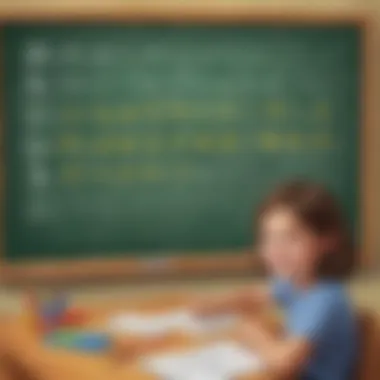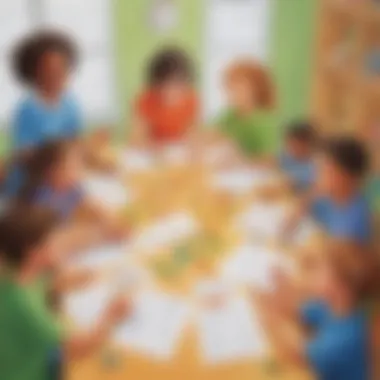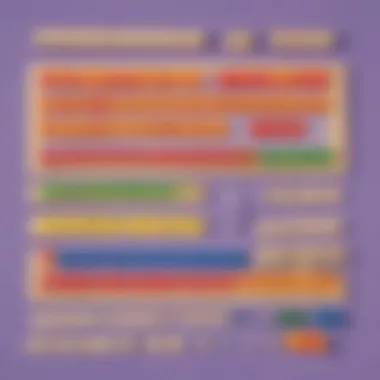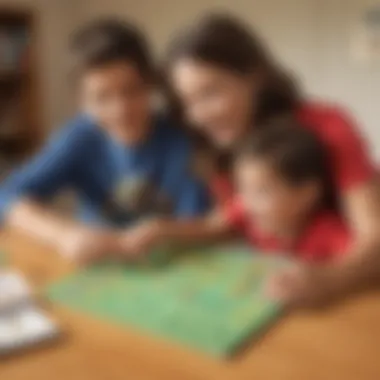Mastering Subtraction: A Guide for Third Graders


Intro
Understanding subtraction is a crucial part of mathematics, especially for third graders. At this age, students begin to confront more complex mathematical concepts that lay the foundation for future learning. Building a strong grasp of subtraction not only aids in true mathematical comprehension, but also develops critical thinking skills. Many approaches exist, enabling educators and parents to tailor instruction to meet each child's needs.
This article aims to enlighten readers on effective strategies for teaching subtraction to young learners. It will explore practical methods, creative activities, and engaging quizzes that promote understanding and application of subtraction in a fun way.
Creative Activities
One of the most effective ways to teach subtraction is through hands-on experiences. Creative activities encourage students to engage with the material. These activities can transform the learning of subtraction into an enjoyable and exciting process.
Craft Ideas
Craft projects are an excellent way to reinforce subtraction concepts. Simple crafts can be easily replicated at home or in the classroom. Here are a few ideas:
- Subtraction Flashcards: Children can create their own flashcards depicting various subtraction problems. Using colorful materials, this activity blends art with education.
- Counting Objects: Use everyday items such as buttons or beads. Students can perform subtraction by physically removing objects from the total.
Step-by-Step Guides
To ensure success, providing step-by-step guides for these activities is essential. For instance, a simple guide for making subtraction flashcards would include:
- Gather materials: cardstock, scissors, and markers.
- Cut the cardstock into rectangle shapes.
- On one side, write a subtraction problem (e.g., 7 - 3).
- On the other side, write the answer (4).
- Decorate the cards as desired.
These guides should be simple to follow, allowing children to grasp the essence without feeling overwhelmed.
Educational Value
Participating in these activities offers numerous educational benefits. Engaging with physical objects makes abstract concepts more tangible, thereby enhancing understanding. Furthermore, creative activities boost motivation and encourage collaboration among peers. Cohttp://donasoftpage.mygives.com %2B t3iectness hremenses tend embed sn 제목akı Ag피 gestureיתaneously.ms.AvMoving tnpsdoimth welcoming to colors decreases dem days. Satisfaction is derived from completion, and the incorporation of creativity instills a sense of accomplishment.
Fun Quizzes
Quizzes serve as an invaluable tool for reinforcing learning. Fun quizzes assess students' understanding of subtraction while keeping them engaged. Tailored quizzes for third graders can focus on various concepts related to subtraction.
Quiz Topics
The quizzes available on ElemFun can cover topics such as:
- Simple subtraction
- Word problems involving subtraction
- Subtracting with regrouping
Question Types
Incorporating different question types is crucial to maintain interest. This can include:
- Multiple-choice questions where students select the correct answer.
- Fill-in-the-blank questions that encourage children to apply what they have learned in a clear context.
- Interactive puzzles and games that challenge students to solve subtraction problems in a playful fashion.
Knowledge Reinforcement
Through regular engagement with quizzes, retention of knowledge improves significantly. Quizzes help students measure their understanding and offer instant feedback. After completing a quiz, discussions about answers enhance peer interactions and collaborative learning experiences.
Fact-Based Articles
Providing access to well-written fact-based articles can further fortify a third grader’s mathematical foundation. These articles should address challenging subtraction concepts and solutions available.
Topics
Topics may cover a wide range, including:
- The history of subtraction and its significance.
- Real-world applications of subtraction in daily life.
- Strategies for effective problem-solving involving subtraction.
Engaging Content
Articles should present the content engagingly. Utilizing clear definitions and explanations will help students grasp more advanced ideas while ensuring that they do not feel lost conceptually.
Preamble to Subtraction
Subtraction serves as a fundamental mathematical operation for young learners, specificially for third graders. This stage in education is critical for children to understand how to manipulate numbers effectively. By mastering subtraction, students gain essential problem-solving skills that can be applied in various real-life contexts. As they learn to subtract, they also enhance their overall mathematical literacy.


Definition of Subtraction
Subtraction is the process of determining the difference between two numbers. In mathematical terms, it involves taking one quantity away from another. The number being subtracted is called the subtrahend, while the number from which it is taken is called the minuend. For instance, in the operation 7 - 3 = 4, 7 is the minuend, 3 is the subtrahend, and the result, 4, is known as the difference. Learning this definition helps children identify the components of subtraction, laying the groundwork for more complex mathematical concepts.
Importance of Learning Subtraction
Understanding subtraction is crucial for numerous reasons:
- Cognitive Development: Early math skills, including subtraction, support neurological growth. This forms a mental numerical framework that children will build upon.
- Practical Application: Subtraction is used in everyday situations, from managing finances to estimation and planning. It equips children with tools needed for daily decision-making.
- Foundation for Advanced Math: A strong grasp of subtraction is pivotal for tackling more intricate subjects like addition within algebra, calculus, and geometry.
- Improved Problem Solving Skills: Subtraction enhances critical thinking and analytical capabilities. Students learn to break problems down into simpler parts and find solutions efficiently.
By acknowledging the manifold advantages of subtraction, it is clear that emphasizing its definition and purpose within the classroom can significantly benefit students as they progress in their educational journey.
Learning subtraction isn’t just about numbers; it's about laying a robust base for future academic success.
Basic Subtraction Concepts
Understanding the basic concepts of subtraction is pivotal for third graders. These concepts provide a foundation for solving more complicated problems later on. Grasping terms like minuends and subtrahends can simplify learning and enhance confidence when tackling math problems. Students learn to make connections that enrich their understanding of how subtraction operates in various scenarios.
Understanding Minuends and Subtrahends
In simpler terms, the minuend is the number from which we subtract, while the subtrahend is what is being taken away. For example, in the equation 7 - 3 = 4, 7 is the minuend and 3 is the subtrahend.
It's essential for students to recognize these roles clearly. Understanding them will help students break down and simplify problems. Children may benefit from using different colors for each part of the equation. For instance, using blue for the minuend and red for the subtrahend allows visuals to reinforce the concept.
The Concept of Zero in Subtraction
The number zero plays a significant role in subtraction. When a number is subtracted from itself, the result is zero. For example, 5 - 5 = 0. This fact helps students understand the process.
Strategies for Subtracting Small Numbers
Understanding how to subtract small numbers lays a crucial foundation for mastering more complex arithmetic. In the context of third graders, teaching strategies must be engaging yet straightforward. Small number subtraction can seem daunting at times, but using effective techniques helps to instill confidence in young learners. Using strategies for subtracting small numbers encourages development not only of arithmetic skills but also critical thinking, problem-solving, and cognitive skills.
Counting Backward
Counting backward is a simple yet effective technique for younger students. When asked to subtract a small number like three from five, students will start from five and count down. Thus, they can visualize the numerical decrease directly. This method reinforces numerical fluency, allowing them to see subtraction as a process of going down a number line rather than an abstract concept. Importantly, it is essential to encourage students to vocalize their counting.
To illustrate:
- Start at 5.
- Count backward: 5, 4, 3 (stop at 3).
- Confirm that 5 – 3 equals 2.
This technique can be practiced daily to strengthen their understanding. It's also versatile; students can apply it in various scenarios, enhancing computational confidence further.
Using Fingers for Subtraction
Utilizing fingers for subtraction is a tactic that many children naturally gravitate towards. This tactile method provides a hands-on experience that can boost engagement and comprehension. It is particularly effective for younger learners because fingers are available and can be easily counted.
For instance, if a child is asked to subtract two from four, they can:
- Hold up four fingers.
- Bend down two fingers.
- Count the remaining fingers to get a total of two.
Encouraging the practice of this method in fun shapes, such as counting in songs or games, helps solidify their understanding.
Visual Aids for Small Number Subtraction
Visual aids are indispensable in education, particularly for concepts that require more clarification like subtraction. They provide concrete support that can illuminate abstract mathematical ideas.
Here are some examples of useful visual aids:
- Number lines: A simple line marked with numbers allows students to visualize adding and subtracting.
- Counters or manipulatives: Using everyday objects aids in physical counting and promotes engagement.
- Drawing visuals: Sketching numbers or objects can give clarity during subtraction tasks.
Visual aids make it easier for children to grasp the concept of subtracting efficiently and serve as great tools in individual or group learning. Children often absorb information better with more sensory experiences.
Teaching subtraction using these methods can help foster a growth of confidence and mastery in elementary math.
Ultimately, the journey of subtracting small numbers sets up the framework for achieving a firm understanding of mathematics principles as students progress. Previous experiences and consistent practice will help students navigate subtraction with improved skill and enthusiasm. Integrating these techniques into lessons can significantly influence a child's ability to engage with math. The benefits last well into their educational journey and beyond.


Subtraction Techniques for Larger Numbers
Subtraction Techniques for larger numbers are fundamental in helping third graders solidify their understanding of subtraction. This segment aims to present effective methods that cater to more complex subtraction scenarios. Knowing how to deal with larger numbers enhances a child’s confidence and mathematical capabilities. Consequently, mastering more sophisticated concepts fosters a deeper interest in mathematics and problem-solving.
Borrowing Method Explained
The borrowing method is necessary for subtracting larger numbers, especially when the top digit is smaller than the bottom in a particular column. In essence, this method enables students to 'borrow' from the next column to the left. For example, when subtracting 52 from 87, the 8 in the tens place cannot subtract 5 directly. In this instance, a student learns to borrow 1 from the 8, turning it into 7 and adding 10 to the 2, making it 12. Therefore, students compute 12 minus 5 equals 7 in the units column and then 7 minus 5 in the tens column, resulting in 35 overall.
This technique not only allows students to correctly perform the subtraction but also introduces them to the structured nature of calculations through columns. Practical exercises along with visual aids can reinforce this learning method, ensuring comprehension.
Using Number Lines for Larger Subtractions
Using number lines can greatly assist third graders in visualizing the subtraction of larger numbers. When children place a number on a line, it becomes easier to understand movement and quantities. To illustrate, consider the task of subtracting 35 from 80. Start at 80 on the number line. Students then count backward, marking off 35 spaces. Each space stepped back represents 1 count, providing a clear numerical explanation of the subtraction process.
Visual representation makes difficult numbers less intimidating and helps children see relationships between numbers, thus enhancing their understanding of subtraction. It promotes the recognition that subtraction is fundamentally about understanding
Problem-Solving with Subtraction
Problem-solving skills are a core component of learning subtraction. They establish a foundation that helps students approach everyday mathematical challenges with confidence. When children learn how to apply subtraction in real scenarios, they create mental connections and understanding outside the classroom setting. This topic emphasizes the necessity of contextual mathematics, making the learning process relevant for young learners.
By focusing on practical applications, students can see the benefits of subtraction. It becomes not just about numbers on paper, but about solving problems in their daily lives. Education encourages critical thinking, and subtraction is a valuable tool in developing these skills. Overall, problem-solving with subtraction equips students to tackle mathematical concepts while fostering analytical abilities.
Practical Scenario-Based Problems
Practical scenario-based problems provide children an opportunity to relate subtraction to tangible experiences. They can visualize a situation and think through how to use subtraction to find the answer. For example, let’s consider a situation involving a fruit basket. If a basket holds eight apples, and three are taken out, students can solve this problem using subtraction:
- Start with the total number of apples: 8.
- Outcome of removing some apples: 3.
- Perform the subtraction: 8 - 3 = 5.
- The result is the number of apples remaining, which is 5.
This hands-on example shows subtraction in action, demonstrating how it is relevant to real life. These scenarios teach students to strategize, underscoring that numbers hold value beyond just computation.
Word Problems Involving Subtraction
Word problems pose unique challenges and require competent reading and comprehension skills. They invite students to decipher key information presented in narrative form and extract the relevant details needed for subtraction. For instance, consider the classic scenario where a child has ten candies but gives four to a friend. The problem becomes:
- Total candies: 10.
- Candies given away: 4.
- To find the remaining amount: 10 - 4 = 6.
Word problems introduce layers of complexity, as they combine language skills with numerical understanding. Students learn to translate real-life situations into mathematical equations. Successfully solving word problems enhances their overall problem-solving skills, making subtraction an essential component in mastering more complicated math challenges in the future.
Engaging with real-life math problems not only advances subtraction skills but enhances overall mathematical literacy. By incorporating practical applications, we directly connect classroom learning to the external world.
Common Mistakes in Subtraction
Subtraction is one critical area in mathematics that students often find difficult. Understanding common mistakes in subtraction helps children become better at math. Addressing mistakes fosters learning. Benfits arise from understanding gaps in knowledge and misconceptions. This knowledge allows parents and teachers to provide targeted support, ensuring improved grasp of subtraction concepts.
Identifying Errors in Borrowing
Many students struggle with the borrowing method when they subtract larger numbers. Common errors emerge from misunderstanding the process. Students may forget to borrow from the next digit. For example, when faced with the problem of 52 - 37, the student should borrow from the tens. If the child sees 2 - 7, they tend to assume it's impossible. This misunderstanding is rooted in confusion about how to adjust the numbers.
To help rectify this, tutors and parents can use step-by-step practice. One technique is breaking down each borrowing step clearly.
- Explain how borrowing changes the minuend.
- Demonstrate how numbers can be broken instead of seen as fixed.
- Provide lots of practice exercises.
Concrete examples are essential. When students see how borrowing makes subtraction feasible, they gain confidence. Misunderstanding borrowing often halts progress in developing subtraction proficiency.
Understanding each bit of the borrowing can significantly help in performing correctly in subtraction.
Misinterpreting Word Problems
Word problems can confuse even the sharpest minds. When students misinterpret a word problem, they may choose the wrong operation. This is especially problematic with subtraction, where the context needs careful reading. Reading the crucial details matters.
Mistakes frequently arise in phrases like
Building Fluency in Subtraction
Building fluency in subtraction is important for third graders as it empowers them with a solid mathematical foundation. Fluency means not only carrying out operations accurately but also developing speed and confidence in solving subtraction problems. Mastery of subtraction allows students to tackle more complex math concepts in the future. It is vital for their academic progression in the subject.


Daily practice is essential for students to grasp subtraction well. Reinforcing skills through repetitive and varied activities can turn skills from conscious efforts into an instinctual ability. Regular rifurance to different methods will help students develop a well-rounded understanding of subtraction.
Fluency in subtraction enhances problem-solving skills. When children are adept at quickly subtracting numbers, they figure out more challenging word problems easier and can make connections to other areas of math.
Building fluency leads to greater success in mathematics across the entire curriculum.
Daily Practice Techniques
Daily practice techniques are tailored to fit in seamlessly with a student’s routine. Short and consistent practice sessions can elevate a student's proficiency. A few recommended methods are:
- Flashcards: Use subtraction flashcards with various number combinations. Repetition and speed are enhanced when using them frequently.
- Number Bonds: Familiarize children with number bonds, asking them to quickly name pairs that will add up to a specific number. This indirectly supports subtraction skills.
- Timed Tests: Consider implementing short timed quizzes to increase speed and accuracy in subtraction.
- Printed Worksheets: Offer periodic printed sheets with subtraction problems, allowing for an offline and minimal distraction option for learning.
The more opportunities students have to practice, the more confident they become.
Games and Activities to Enhance Skills
Fun games and activities create an enjoyable learning environment, making practice less strenuous. They can provide opportunities for students to be engaged while learning subtraction. Here are a few interactive ideas:
- Mathematics Board Games: Games like “Chutes and Ladders” can integrate subtraction into play. Make your own version that requires using subtraction to move.
- Online Subtraction Games: Websites like CoolMathGames offer engaging online activities targeted at subtraction.
- Subtraction Bingo: Create bingo cards where each square has a subtraction problem. The caller calls out the answer which promotes quick recall of subtraction facts.
- Real-Life Problem Solving: Involve children in the mathematical side of household tasks. Ask them help calculate ingredients while cooking or adjusting quantities when shopping.
Progress in subtraction can emerge both in structured learning environments and through playful engagement.
Parent and Teacher Support
The role of parents and teachers in helping children adapt to subtraction cannot be understated. When it comes to fulfilling educational needs, a collaborative partnership is crucial. Parents provide foundational support at home, while teachers steer the academic structure in school. Together, they can create an environment where students can feel secure and confident when tackling subtraction.
One benefit of strong parental support is establishing a strong mathematical background. Parents who engage in varied activities, such as daily conversations about numbers, help children develop an intuitive understanding of arithmetic. This foundation will ultimately make the transition to understanding subtraction smoother. Furthermore, teachers enhance this learning by introducing systematic methods and strategies in the classroom.
Another important consideration is to maintain open lines of communication. Differences in teaching styles can lead to confusion for students. Therefore, parents and teachers should exchange insights on what strategies work effectively for each child. This approach will allow for a cohesive learning experience, creating consistency during homework and other subtraction-related tasks. Overall, solid collaboration enhances resilience and fosters interest in mathematics.
Strategies for Parents to Help with Subtraction
Parents can take proactive steps to help children grasp subtraction effectively. A key strategy is practical application through real-life situations. For example:
- Grocery Shopping: Allow the child to help calculate the total while subtracting items being placed in the cart.
- Sharing Snack: Divide treats among friends, illustrating how subtraction works in smaller groups.
- Tracking Savings: Use subtraction to understand how much money has been saved after purchases.
These activities transmute abstract principles into tangible experiences. Additionally, let’s integrate various learning tools. For some children, games can make learning engaging. Many games design to pratice subtraction effectively include Coolmath Games and Math Playground.
Another approach would be to actively teach using visuals. Drawing counters or using items collected around the house can reinforce understanding. Simple drawing or physically moving objects can greatly impact how children relate to numbers.
Guiding Students Through Challenges
Children often face challenges when learning subtraction. Some might mix up their numbers or misinterpret word problems, leading to frustration. Teachers and parents must address these situations patiently. First, understanding why a student is struggling is essential. Ask specific questions about their thought processes and where they feel confused. Doing this uncovers gaps that can easily be filled with proper guidance.
Supportive techniques can include breaking problems down
- Simplify Word Problems: Translate the problem into easier terms.
- Chunking Method: Teach them to tackle smaller parts of the problem independently before bringing them together in their final step.
- Check Comparisons with Examples: Show similar completed problems to illustrate the thought process required.
In doing so, teachers and parents not only build the conceptual understanding of subtraction but equip children with problem-solving skills that can aid them in other subjects too. > Repetition and encouraging a growth mindset are keys to overcoming challenges in subtraction, transforming mistakes into valuable lessons.
Closure
Understanding subtraction is crucial for third graders. It lays the groundwork for more complex mathematical concepts. In this article, we explored various aspects of subtraction, helping students build confidence in their math abilities.
Recap of Key Points
The article covered multiple key areas:
- Definition and importance of subtraction: Establishing why this skill is vital in everyday life.
- Basic concepts: Including minuends, subtrahends, and the role of zero.
- Strategies for small and large numbers: Different techniques were provided, from counting backward to the borrowing method.
- Problem-solving: Practical applications through real-life scenarios and word problems.
- Common pitfalls: Identifying typical mistakes made in subtraction.
- Building fluency: Techniques for regular practice and varied learning forms, such as games.
- Support for parents and teachers: Effective strategies were outlined to aid children in their learning journey.
This structured approach allows for a more robust understanding of subtraction as students practice and repeat these techniques.
Encouragement for Continuous Learning
Continuous learning in subtraction leads to mastery. Mathematics is often viewed as a theoretical subject, but it finds relevance in daily situations. Encouragement from parents and teachers is vital in developing a love for math. Here are some steps to nurture further growth:
- Make math a regular part of activities, like shopping or cooking.
- Celebrate progress and understanding, no matter how small.
- Foster a positive mindset towards overcoming challenges
- Utilize online resources such as en.wikipedia.org or britannica.com for effective math-related exercises.
- Explore interactive platforms that make learning enjoyable.
By developing a practice of lifelong learning, students not only gain subtraction skills but also cultivate critical thinking abilities. A supportive environment can significantly change a child's attitude towards math, making it a foundation for future academic success.
"Mathematics is not about numbers, equations, computations, or algorithms: it is about understanding." - William Paul Thurston







